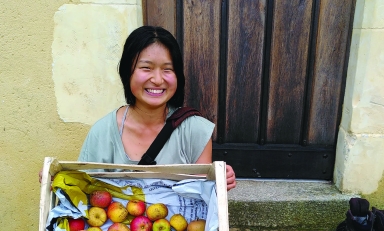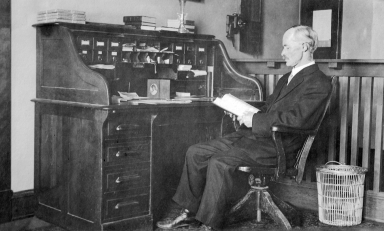
Readers weigh in on the Herrick organ, Addie McMenamin ’40, the Rev. Dr. William Barber, and the “Faces of Oxy”
Delayed Gratification
Many thanks to David Kasunic and Edmond Johnson for rescuing the Herrick organ (“Organ Recovery,” Spring)! It is a true treasure and needs to be played and shared. As an organ performance major at Occidental, I studied with David Craighead and Clarence Mader. I gave my junior and senior recitals in Thorne Hall, so I had to learn how to deal with the time delay (the console being in the front of the hall, and all of the pipes in the back of the hall).
Carolyn Pryor ’57
Campbell
Out of Sight
It was gratifying to read Peter Gilstrap’s article on the Herrick Chapel Schlicker organ, with a few references to the history of the organ at Oxy. There is a general misconception about the organ per se, and Gilstrap gives this away in his second paragraph.
Accordingly, I would submit that no musical instrument of any kind at any point in history is visually hidden away from its player or its listeners. Does anyone go to a concert by the Los Angeles Philharmonic orchestra and not expect to see the orchestra as well as hear it—not see the violinist or pianist as they play a concerto? I think not. So why celebrate the fact that the Herrick Chapel organ is hidden away?
It is a fact of musical life, many hundreds of years old, that the pipe organ has been out in the open for all to see and hear it, which, of course, seems to be axiomatic with all musical instruments. European builders have always understood this and have been aware of the organ’s intrinsic visual beauty. This is a notion American architects have not understood until rather recent times, and have previously pretended to solve the problem of pipe organ placement by simply hiding it.
The real question, then, is this: Why did Herrick Memorial Chapel have to be so badly designed with respect to the pipe organ placement in it given in memory of Mildred Miles? I know for a fact that the late Clarence Mader, College organist at the time, fought to have the organ properly placed in the open. Besides the sheer musical and artistic visual aspects of his idea, regular servicing, i.e. tuning and occasional regulating of the pipe organ, would have been less expensive for the College over the years, since access to it would be immeasurably easier. But, no, Mader’s counsel was ignored. Why? Because the architect had a fixation on the stained glass window in the middle of the west wall and thought the organ would detract from this. How little he understood!
Having the pipe organ out in the open would have saved the building of the vertical closets on either side of the sanctuary, a cost themselves, while the pipes could easily have been designed to accent the stained glass window in the center and add to the overall beauty of the chapel.
The premise is simple: When one pays a dollar for an organ, one expects to hear a dollar’s worth of organ, not 60 cents’ worth.
George E. Klump ’57
La Crescenta
Addie’s Magic Moments
I worked with Addie McMenamin ’40 in the late 1970s (“Alumni’s First Lady,” Spring). She was my mentor. Her humility, kindness, gentle diplomacy toward all, and resolute sense of fairness was combined with a keen and unwavering business savvy.
Addie had an encyclopedic memory for alumni as well as any and all familial Oxy connections. Regardless of how much time had passed since an alumnus or alumna had been on campus, Addie was able to extricate some personal tidbit of information on that person that amazed them and us.
During an alumni trip to Ireland with Bob Ryf, then dean of faculty, she helped me rescue an alumna who had missed a connecting flight to Dublin. (No cellphones back then!) The lost traveler had no way to contact us but was met days—and dazed— later at the Sligo train station by Addie’s smile and warm greeting. It also was during this trip that I learned of her daily search for a “magic moment”—an outward symbol of her unwavering optimism.
Addie choreographed class reunions, local and regional events, Fifty Year Club gatherings, and myriad presidential receptions with military-style organization but always with a smile and calm demeanor. She held dear a commitment to the core values of a liberal arts tradition.
Addie dedicated herself and her work to Oxy. It was an honor to know Addie and John, whom I stayed in touch with during their devoted and loving life together.
Jean Keefe Parry ’70
Santa Barbara
Bullish on Barber
I’m a California native, but after 36 years in North Carolina, I’m a William Barber fangirl (“‘A Grownup Conversation,’” Spring). Rev. Barber recalls the desperate and determined leaders of the ’70s, the people who made us believe we could change anything.
When I first moved to North Carolina in 1981, the state was a beacon in the American South, illuminating the benefits of education, environmental sensibility and empowerment. Over the past few years, as that light has dimmed, Rev. Barber has injected energy to inflame us back into action and belief. He is the real deal, and I commend Oxy for recognizing his role in protecting what is right and good in the American Dream.
Barber has announced his resignation from the N.C. NAACP later this year to launch a renewed Poor People’s Campaign. Stay tuned: He is not done.
Diane Lennox ’73
Durham, N.C.
Art Appreciation
I really appreciated the photo and caption on Rafa Esparza’s art installation (“Faces of Oxy,” Spring). It’s nice to see such interesting art going up around campus! I can just picture myself walking up Mount Fiji and finding such a beautiful sculpture with the face of kitchen assistant Freddy Ortiz on it. One of the things I loved so much about Oxy when I was there was getting to know the dining and facilities staff, and it’s awesome to see this aspect of Oxy put into physical form in such a unique way. I would love to see the entire installation sometime and to hear the oral history accompaniment.
Thanks to all who contributed to such a wonderful project. I’m glad programs like the Kathryn Caine Wanlass Charitable Foundation continue to provide support for endeavors such as this.
John Eaton ’11
New Orleans



